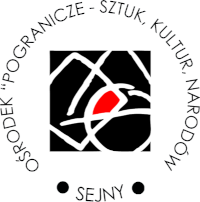The Seat of the Centre
The Borderland House, the new seat of the Centre “Borderland of Arts, Cultures and Nations”, is a restored historic building with its own long history. It is known locally as the Old Post, as for many years, since the turn of the last century it served as the town post office. Its history goes back earlier and is connected with the mid-nineteenth century Jewish commune that built here a strong centre of enlightenment (Haskalah). It was then that the writer Tuvie Pinkas Shapiro founded here a Jewish secondary school, one of the first lay schools of that type, offering, apart from religious training, instruction in such subjects as geography, mathematics and humanities.
A new post office opened in Sejny in 1992. The legal heir of the owners of the Old Post, Jan Polkowski, sold the building to the town at a price below its market value on the condition it is renovated and designated for cultural and educational purposes. In 1997, Sejny Council decided to cede the Old Post gratuitously to the Borderland Centre. The renovation project, after Rafał Winiewicz’s design, was performed by Krystyna and Bronisław Kotwica building company, with the financial assistance of the Suwałki voivodship authorities. The renovation work continued with the eventual aid of the Marshal Office of the Podlaskie Voivodship. It also received some support from the General Conservation Office. Furnishing of the projection room, film and photography studios of the Centre for Documentation of Borderland Cultures was made possible thanks to a grant from the Foundation for German-Polish Cooperation. 23 January 2002, the 11th anniversary of the foundation of the Borderland Centre, was slated for the ceremony of the opening of the Borderland House.
The building of the former Yeshiva (Talmudic school), situated between the Borderland House and the White Synagogue, is used at the moment by the Foundation as the seat of the Sejny Jazz Co-operative (formerly Papuciarnia Gallery), comprising also fine arts and music studios. The building houses also the Sejny Public Library. The Sejny Jewish community was fortunate in having eminent teachers and spiritual leaders. Almost all of the 19th century Sejny rabis were also eminent scholars. The most eminent of those was undoubtedly Moshe Yitzhak Avigdor who assumed his office in 1846. This well-known organizer and philosopher, soon after his arrival in Sejny, opened here a yeshiva, a Talmudic school, endowing it with a popular-revolutionary profile. It was especially popular among the Maskils, the followers of the Jewish Enlightenment and for a short time it became the centre of the Haskalah for the whole of Lithuania. The school was a venue of meetings of the most eminent rabis. The Jewish Talmudic school operated here until 1939. After the war the building housed a factory of slippers. In October 1990, the town authorities allowed Borderland to use a part of the building of the former Yeshiva. It became then the first headquarters of the Borderland and the Centre for Documentation of Borderland Cultures. Organized here was also a chamber stage (concert, performances, exhibitions) and a theatre storehouse. In 1990, the town made over the building of the synagogue to Borderland. It houses, at present, the White Synagogue Gallery and Borderland Bookshop. It is also used as a venue for meetings, symposia, conferences, exhibitions, concerts and theatre performances.
The earliest, shingle roofed, synagogue was erected in 1778. Its licence was issued by Father Bortkiewicz, the Superior of the Dominican Friars, the then owners of the town. In 1885, Rabi Moses Becalel Luria started the construction of the, existing until today, brick synagogue. The synagogue takes its name after the white colour of its walls and interior. Architectonically, it is an eclectic building with elements of Gothic and Neoclassicism. The synagogue interior combines the Gothic six-part rib vault with the central Baroque arrangement emphasized by the placement of the four pillars. The synagogue has a nave with parallel two aisles. The niche in the eastern wall used to be the place for keeping the Torah. Lost are the interior polychrome and the bimah that used to occupy the middle of the nave in between the four pillars. The synagogue miraculously survived the war. The building was turned by the Nazis into a fire station. After the war it was used as a storehouse of artificial fertilizers and town transport terminal. It was the period of substantial devastation of the building. The renovation work started in 1978 and lasted until 1987.
Apart from the brick synagogue there were two more prayer houses in town. The synagogue was most probably used only on the occasion of larger religious festivals. During the Second World War the Nazis turned the synagogue into a fire station. After 1945, it was a depot, shop store and a storehouse of artificial fertilizers. The end of the devastation came with the renovation of the building in 1978-1982 carried out by the State Atelier for Conservation of Architectural Property and restoration of the original interior. The synagogue has a nave with parallel two aisles on rectangular plan 19m x 25.8m. Preserved was the Aron ha-Kodesh niche and the four richly profiled pillars once surrounding the bimah. Of the original furnishings nothing remains, all was looted and carried away by the Nazis.
The contemporary White Synagogue was granted to Borderland Centre and became a venue of meetings, concerts, performances and exhibitions.
Before the Borderland Centre took care of the synagogue its curator had been the artist Wiesław Szumiński. The first notable exhibition organized then here was the presentation of the artistic output of Andrzej Wajda (Andrzej Wajda - the Portrait) organized by the Sejny Cultural Centre. The unique architecture, spaciousness and acoustics of the place make it a splendid venue for organization of various events, meetings, concerts and theatrical performances.

